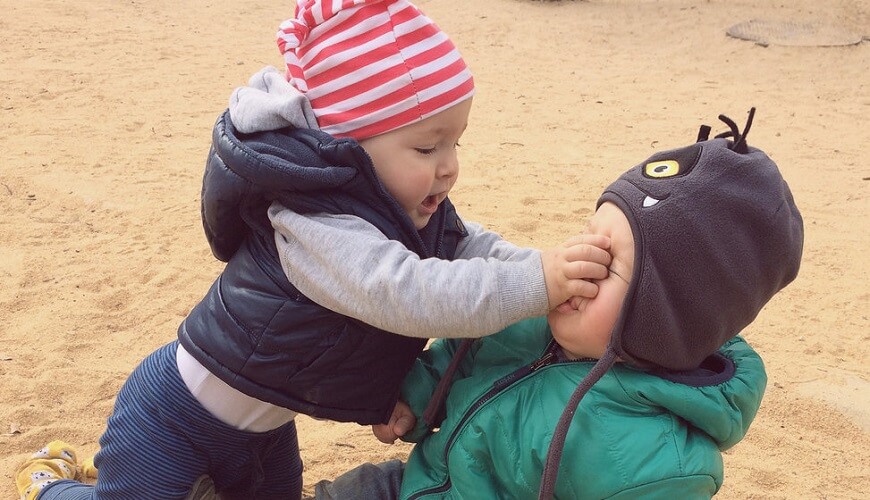Some aggression is normal, experts say; parents can respond with redirection or distraction rather than by punishing the child with anger, yelling or spanking.
Behavior problems in children, especially aggression and defiance, don’t get a great deal of sympathy, said Dave Anderson, a psychologist who is senior director of national programs at the Child Mind Institute in New York City. “For a child to get better requires just as much empathy and scaffolding as for a child who might be depressed, but behavioral issues inspire nowhere near as much empathy.”
There is a persistent belief that these behaviors reflect poor parenting, he said, but in fact, there is often a strong biological component to behavioral issues, and the responses which come naturally to most parents faced with these behaviors may not have the desired results.
“If you’re going to have persistent behavior problems involving aggression and defiance, it’s already elevated at 2,” said Michael F. Lorber, a senior research scientist with the Family Translational Research Group at New York University.
In a study published last year in the Journal of Pediatrics, Dr. Lorber and his colleagues looked at 477 children from 6 to 24 months of age, asking their mothers to report on how often in the past month the children had shown specific behaviors ranging from kicking and hitting to pulling hair, biting and even hurting animals.
These behaviors were very common, with some actions (hitting or smacking someone) much more common than others (hurting animals). The prevalence of the behaviors tended to increase over time, with hitting peaking at 18 months, and kicking and pushing, as well as throwing objects at people, peaking at 20 months. “Eight of 10 kids were hitting and smacking at 18 months,” Dr. Lorber said. “The terrible twos started before 2.”
Not only were more toddlers hitting as they got older, but they were hitting more frequently, so that the 24-month-olds were reported to be hitting nearly four to six days a week.
On the other hand, hair-pulling decreased with age, as did scratching, and the researchers speculated that the increased incidence of those behaviors among the younger children may reflect the close contact they have, since they are usually being held.
The researchers suggested that pediatricians can reassure parents that these behaviors are normal in small children, but also guide parents, right from the beginning, in setting limits and responding in ways that may help — redirecting or distracting a child — rather than by punishing the child with anger, yelling or spanking.
Though these behaviors are seen in almost all children, those toddlers who act aggressively more frequently and consistently may need more help — and so may their parents. “These behaviors are not inconsequential,” Dr. Lorber said. “Kids who are more aggressive also tend to be more tantrummy, more irritable.”
And those problems persist as the children grow, he said. “Although aggression is normative, some kids do it a lot more than others,” Dr. Lorber said. “The kids who are really high frequency — it’s happening every day, multiple behaviors are happening every day — those are probably the kids who have passed some threshold where that would warrant special additional attention like referrals to parenting intervention services.” They should also be evaluated to make sure that nothing else is going on, from a physical problem causing pain and irritability to an impairment in hearing or speech causing frustration.
Dr. Anderson said that aggressive behavior in children at the extreme can be one symptom of a behavior disorder. The important questions in separating out normal (if unpleasant) behavior from a disorder include the frequency, intensity and duration of the behavior, and whether it is making trouble for the child, getting him kicked out of preschool, or leaving her friendless on the playground.
But while parents may think about this as a dichotomy, he said — does the child have a disorder or not — in fact, clinicians who work with behavior problems believe that there are strategies that every parent could use.
“Our instincts as human beings are often wrong,” Dr. Anderson said.
“We tend to be negative behavior detectors.” When two siblings are playing quietly together, he said, “most parents are thinking, don’t jinx it, or let me go do something on my to-do list.” But when there is conflict, parents respond with anger and threats and punishment.
Those ways of responding to the negative behaviors, he said, are unlikely to work — with small children, with adolescents or with adults. “We don’t tell partners to yell at partners as part of couples therapy; we don’t tell bosses to yell at employees for better productivity.”
Parents should set up clear expectations before a problem develops, he said, thinking about how to manage getting ready for school the next morning, for example, if today did not go well. And they should offer specific positive feedback for positive behaviors, rather than worrying that they will “jinx” those good behaviors.
If a child is having significant behavior problems, parents should be ready to ignore minor misbehavior, he said, such as verbal disrespect or whining. So pick your battles, and don’t give in to the idea that a big punishment is the way to go. “With aggression, lots of parents have a ‘go big or go home’ approach: My child picked a fight, so no play dates, no TV,” privileges rescinded indefinitely, Dr. Anderson said. “The reality is that big punishments do not translate to better behavior.”
Instead, punishments should be immediate, consistent and used in small doses; parents should look for ways to remove a privilege for a short time, and establish clear expectations for better behavior. Thus, if a child picks a fight with another child at school, a parent might impose a specific consequence (such as no screens for two days), offer a clear discussion of keeping your hands to yourself, and go over some alternative strategies for moments of frustration: take a break, tell a teacher, interact with another peer. And then, having defined the good behaviors, the parents — and perhaps the teacher as well — need to look for occasions to draw attention to those behaviors.
“The moment we see him be mildly frustrated but take a break, whether consciously or unconsciously, we need to catch him,” Dr. Anderson said, and tell him he did the right thing.
Some children who act aggressively may actually be anxious, Dr. Anderson said, or may be showing the irritability that can go with depression. Children who have experienced trauma may also have behavioral symptoms.
“If you’re worried that your child is having significant behavioral issues, see a mental health professional,” Dr. Anderson said. Research shows, he said, that parents often wait years from the time they know something is wrong before they seek help.
“The biggest cost of parents waiting is the child continues to have failure in peer relationships, failure in forming relationships with adults, injury to self-esteem,” he said. “Let’s get people the support they need around managing their child’s behavior, or support for the teacher, or social skills training to help the child have more rewarding friendships.”
RELATED POSTS
WHAT IS EDUGETHER
Edugether is an all-day english-spanish home child care with a spanish immersion education program with focus on their social, cognitive, language and physical skills.
HOW CHILD LEARN
Touching, squeezing and breaking is necessary to know. This learning experiences with your child, help to significant and trascendental moments in their lives.
BRAIN DEVELOPMENT
A child’s early exposure to language is at the heart of development. Aspects of early language environments have been found to predict language skills, cognitive skills, and academic achievement.




